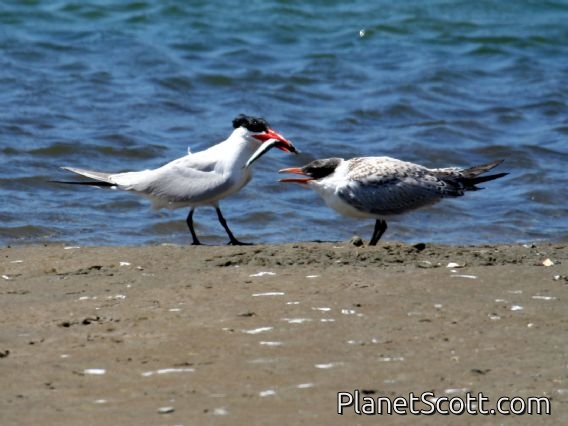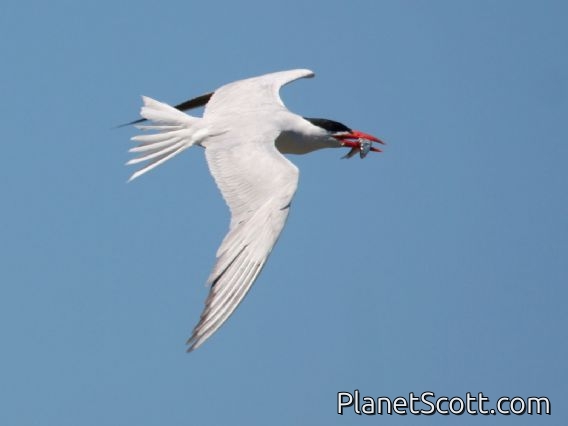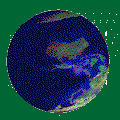Caspian Tern (Hydroprogne caspia)

Caspian Tern (Hydroprogne caspia)

Caspian Tern (Sterna caspia) Adult and Juvenile

Caspian Tern (Sterna caspia)



×




Caspian Tern (Hydroprogne caspia)

Caspian Tern (Sterna caspia) Adult and Juvenile

Caspian Tern (Sterna caspia)
About Caspian Tern (Hydroprogne caspia)
- Kingdom: Animals
- Phylum: Chordates
- Class: Birds
- Order: Shorebirds and Allies
- Family: Gulls, Terns, and Skimmers
The Caspian tern is the world's largest species of tern, with a subcosmopolitan but scattered distribution. Despite its extensive range, it is monotypic of its genus, and has no accepted subspecies. The genus name is from Ancient Greek hudro-, "water-", and Latin progne, "swallow". The specific caspia is from Latin and, like the English name, refers to the Caspian Sea.
Source: Wikipedia
Trips
Visits
-
2006-04-19
Candlestick Park, United States of America -
2006-08-26
Candlestick Park, United States of America -
2007-03-29
Heron's Head Park, United States of America -
2007-04-07
Torrey Pines State Reserve, United States of America -
2007-07-28
Crissy Field, United States of America -
2008-01-09
San Blas Ponds, Mexico -
2012-01-13
Otago Peninsula / Dunedin, New ZealandSeen on mudflats at Warrington. -
2012-01-17
Okarito, New Zealand -
2012-08-12
Redwood Shores - Radio Road, United States of America -
2012-11-11
Lakefield National Park, Australia -
2013-02-02
Pak Thale, Thailand -
2013-03-30
Heron's Head Park, United States of America -
2013-04-16
Aransas NWR (CTC 037) (Aransas Co.), United States of America -
2013-08-05
Heron's Head Park, United States of America -
2013-11-02
Central Island National Park, Kenya -
2014-05-26
Heron's Head Park, United States of America -
2015-04-18
Mori Pt, United States of America -
2015-04-25
Jenner, United States of America -
2015-04-26
Jenner, United States of America -
2015-05-24
Montrose Point, United States of America -
2015-05-25
Montrose Point, United States of America -
2015-05-26
Nelson Lake Forest Preserve, United States of America -
2016-05-06
Montrose Point, United States of America -
2016-08-06
Crissy Field, United States of America -
2016-12-30
Ras Al Khor, United Arab Emirates -
2018-05-20
Jenner, United States of America -
2018-09-21
Oceano, United States of America -
2018-09-23
Oceano, United States of America -
2018-10-13
Crissy Field, United States of America -
2019-06-08
Crissy Field, United States of America -
2021-05-24
Montrose Point, United States of America -
2021-05-25
Montrose Point, United States of America -
2021-05-26
Montrose Point, United States of America -
2021-05-27
Montrose Point, United States of America -
2021-05-28
Montrose Point, United States of America -
2021-05-29
Montrose Point, United States of America -
2023-04-04
Rottnest Island, Australia -
2023-04-05
Rottnest Island, Australia -
2023-04-19
Cape Range National Park, Australia -
2023-04-21
New Beach, Australia -
2023-05-11
Montrose Point, United States of America -
2023-05-12
Montrose Point, United States of America -
2023-05-13
Illinois Beach State Park, United States of America -
2023-07-22
Heron's Head Park, United States of America -
2024-02-21
Naha Triangular Pond, Japan -
2024-05-31
Heron's Head Park, United States of America -
2024-10-14
Santuario de Fauna y Flora Los Flamencos, Colombia -
2025-05-05
Presidio - Battery Godfrey, United States of America




